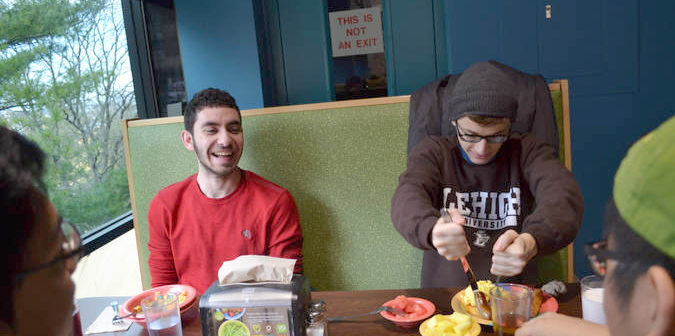Emma Ferguson, ’21, has been a vegan since the fifth grade. In her home city of Portland, Oregon, she is used to having an abundance of options — from restaurants to high school cafeterias — that accommodate her dietary needs.
When she came to Lehigh, however, Ferguson felt limited by the menu items provided in the dining halls.
“I would always call my parents freshman year and tell them ‘I’m just so hungry and I don’t know what to eat,’” Ferguson said.
All three of Lehigh’s traditional dining halls — Rathbone, Lower Cort and Broadhead — have daily options for students with dietary restrictions and allergies, but Ferguson said they are limited and often repetitive.
Steph Rosenthal, ’20, who follows a gluten- and fructose-free diet, said she also found it difficult to eat at the dining halls but thinks Lehigh is becoming more accommodating of students with restrictions.
Carrie Gerencher, a registered dietitian and Lehigh’s campus nutritionist, said there are always options for people with dietary restrictions either at regular food counters or at Simple Servings, a station located in each dining hall that specifically serves food for students with allergies or dietary restrictions.
While gluten-free food options, labeled ‘GF,’ are scattered throughout each dining hall, Gerencher said vegan options, labeled ‘VG,’ can be found at Simple Serving stations, along with a separate meat option.
Still, some students are left wanting more, like Ferguson, who said she often got tired of eating the same vegetables or making salads at the salad bar.
“There was always a vegetable to eat and there should be that for everyone, but often times they did not make an effort to get a protein for us,” she said. “I couldn’t just eat the vegetables day-in and day-out.”
After the fall semester of her first year, Ferguson resorted to other dining options both on and off campus such as the Global Café in Williams Hall. At Williams, Ferguson said she could buy salads and noodle bowls with tofu in order to incorporate more protein in her diet.
Gerencher said there are ways students with dietary restrictions can enhance their meals or “hack the menu,” like bringing vegetables to the pasta station to have them sautéed. She encourages students to meet with her to best utilize the dining halls to meet their needs.
“Students are hesitant to talk to anybody and I am always telling them to get to know the chefs, and they can get to know who you are and what you’re looking for,” Gerencher said.
Although Lehigh is not looking to expand the special dietary-needs sections at dining halls right now, Gerencher said the UC renovation will include changes in the Lower Cort dining hall to provide a larger vegan and vegetarian section.






Comment policy
Comments posted to The Brown and White website are reviewed by a moderator before being approved. Incendiary speech or harassing language, including comments targeted at individuals, may be deemed unacceptable and not published. Spam and other soliciting will also be declined.
The Brown and White also reserves the right to not publish entirely anonymous comments.
3 Comments
Students with dietary restrictions need to realize that cooking for thousands of students 3 times per day is different from cooking at home. When you go to the grocery store for yourself, you can pick and choose exactly what you want to eat – purchasing managers for college dining halls don’t have that luxury. If you were lucky enough to come to Lehigh from a home where your needs were always accommodated, it can be hard to adjust to the realization that everyone isn’t going to do what your parents did. Based on my experience as a professional event manager that works all over the country with a wide variety of groups, I’m guessing the percentage of vegan/gluten-free/vegetarian/other needs students at Lehigh is probably less than 5%. It’s nearly impossible to provide that level of “personalization” and variety for such a small number of people when you’re trying to feed thousands on a fixed budget. You have to expect a certain amount of repetition and fewer choices when your allowable options are so limited, compared to the rest of the group of which you’re a part. I completely sympathize with your plight – I personally found the food in Lehigh’s dining halls to be terrible when I was a student there, and I didn’t have any dietary restrictions at all. But I made do for the 1st year and moved off campus as a sophomore, so I could cook for myself and eat whatever and whenever I wanted. It’s hard, but it’s also an important lesson to be learned about the “real world” – people aren’t always going to accommodate you in exactly the way you want, and it’s up to you as an adult to find the workarounds and solutions to these problems.
Do you know, Nancy, I can think of nothing more real-world than paying sixty-seven thousand dollarinos for 30 weeks’ or so worth of service for one person, asking for some nice robust vegan meals to be made available throughout, and reasonably expecting to get them.
Why, what do you charge?
Oh, for goodness’ sake, Nancy, you’re a corporate event planner. Of course you’re not seeing the shift in dietary habits, you’re in the land of “why treat people reasonably when you can use them and throw them away like garbage”. Well, take this article as a message from the real world, because here’s who’s coming to work for your corporations, and here’s some of who’s already there. It’s common for people under 30 to be vegan or vegan-inclined and to have chosen that in childhood. Nobody really talks about “vegetarian” anymore. And food sensitivities are legion — you can’t even bring mint or cinnamon into my building at work because someone’s got a severe allergy. FODMAP should be part of your repertoire. I’m sure that if you go over to someone else’s to eat, they ask you whether you have any limitations in what you eat.
If your job involves food provision, there isn’t really an excuse for not knowing how to cook well and variously for a pretty good range of diets on a time-and-money budget. It’s not hard, especially if you’re staying put and don’t have to worry about sourcing ingredients in new places all the time. (My kid decided on her own to give it a go last summer, found a four-week, well-varied meal plan online that looked fine and like it ticked all the nutritional boxes, went with me to shop for herself, cooked her own food. It was all nice and in general less expensive than what I usually buy. It was also not a major departure from how she normally eats, since her daycare was more or less vegan, and she kept a lot of those habits. Let that sink in a minute, by the way. The daycare, more or less vegan while charging three dollars an hour for care. Mob of kids and staffers to feed, plus parents who’d dropped by. Snacks, lunch. These kids ate raw broccoli and olives as snacks, and liked them. Cooking for lunch started early and it smelled great.) Frankly I don’t really understand why a university wouldn’t assume about a third or half the kids are vegan, and make those offerings part of the normal rotation. Given the choice, many of the kids who aren’t currently vegan would probably start eating that way, just because the food’s tasty/healthy/low-impact.
Cal manages all this beautifully, by the way, and it’s a state university serving multiples of the students Lehigh has. You go wandering around on campus at Berkeley, and you eat there or go to a snack bar, and you realize that foodwise you’ve been living like an animal. So much wonderful produce, so many amazing, clean, healthy meal options, mostly inexpensive. It happens because they care about it there. (The produce quality also happens in part because of where they are, but that’s not the only factor involved.) That’s really the main difference.